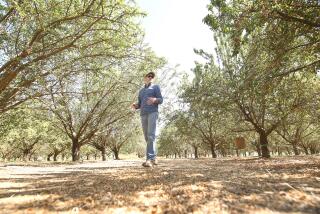Biological War on Ash Whitefly Ready to Begin : Agriculture: Scientists hope parasitic wasps will slow the spread of the pest. The first vials containing the tiny parasites will be uncorked next week.
RIVERSIDE — The first volley in a carefully plotted biological war against the ash whitefly will be fired next week when researchers hunting for ways to control the destructive and rapidly multiplying pest release 50 parasitic wasps near a San Fernando Valley park.
Scientists hope the wasps, which do not sting humans and are smaller than a pinhead, will slow the spread of the whitefly, which has defoliated trees from the Mexican border to Sacramento and is viewed as a substantial threat to the state’s thriving nursery and citrus industries.
One week from today, small vials containing the tiny wasps will be uncorked beneath the branches of whitefly-infested ash trees at the Balboa Sports Center parking lot in Encino, scientists at UC Riverside said Wednesday.
That action will be followed later this month by similar test releases in Orange, Riverside, San Bernardino and San Diego counties. In all, 300 of the specially imported wasps will be deployed this fall, with as many as 10,000 more scheduled for release in the spring of 1990.
The black-and-gold wasps, which were imported from Israel and Italy in midsummer and have been reproducing in UC Riverside’s federally approved quarantine laboratory ever since, are parasitic insects that can only multiply by laying their eggs within the whitefly.
A female wasp inserts her eggs into a juvenile whitefly, known as a “nymph,” through a tube called an ovipositor. The wasp larvae then develops by feeding off the tissue of the whitefly, which ultimately dies when the wasp becomes mature and chews its way out.
“It’s classic biological control, and we have every reason to be confident that this project will succeed,” said Tim Paine, an associate professor of entomology at UC Riverside, where scientists are working with $95,200 in emergency grants to combat the whitefly.
However, even if the wasps prove effective against the whitefly, residents irked by the swarming pest and growers fearful of its threat to crops are not likely to detect any sign of population reduction for at least two years, scientists say.
As for the 300 wasps being turned loose this month, they are not expected to slow the whiteflies’ spread at all. Rather, Paine said, it is a means for determining how the imported parasites will fare in Southern California’s winter climate.
“This wasp has reproduced successfully in the laboratory, so we want to see how it does under realistic conditions,” Paine said. “We also recognize there is a lot of public concern about the whitefly and we’re anxious to respond.”
Larger releases are not possible yet because not enough wasps have reproduced, he said.
Since the whitefly was first spotted in California at a Van Nuys fruit stand in August, 1988, state agricultural officials and scientists have mostly been forced to watch helplessly as the non-native pest swarmed through the state--free of the natural predators that control its population in Europe and elsewhere.
Tests have shown some pesticides are effective against the whitefly, but only as short-term measures: trees are reinfested within a week. Moreover, because the whitefly has infested such vast areas--many of them heavily populated--widespread insecticide spraying is viewed as impractical and undesirable.
Also, whitefly eggs have proven difficult to treat with pesticides because they are laid on the underside of leaves.
Consequently, scientists are hoping biological control will do the trick, and eight species of enemy insects have been imported for study at UC Riverside. In addition to the parasitic wasps, there are wasps that paralyze and kill whiteflies outright as well as two predatory beetles from Israel, relatives of those that eat aphids on roses.
So far, only two of the wasp species have reproduced in the laboratory, university officials said.
Experts believe that the whitefly--which weakens and ultimately defoliates trees by sucking the juices out of their leaves--was accidentally imported from Europe or the Middle East. While so far its destructiveness has been limited to shade trees and back yard fruit trees, scientists say it is only a matter of time before the state’s $634-million citrus industry is attacked.
On top of that, the pest has made life miserable for residents in many heavily infested areas of Southern California, spoiling barbecues and ruining patio furniture and automobile paint jobs with the sticky secretion it leaves behind.
“It’s only been here 15 months, and its population explosion has been incredible,” Paine said. “Last year, we could barely find it in Riverside, and now it’s everywhere.”
More to Read
Sign up for Essential California
The most important California stories and recommendations in your inbox every morning.
You may occasionally receive promotional content from the Los Angeles Times.










